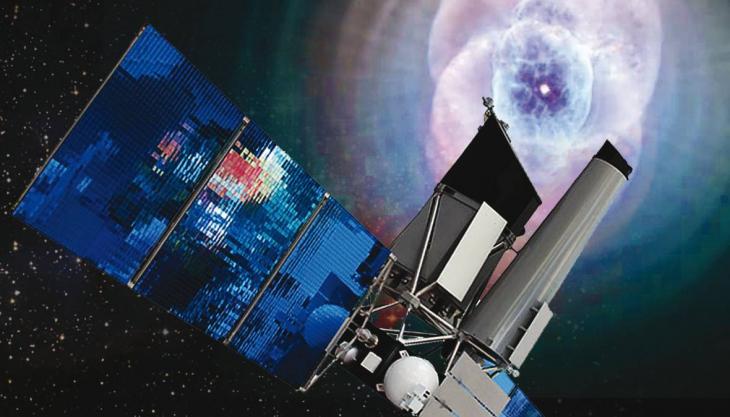High-Energy Astrophysics

Head of the department
Professor of the Russian Academy of Sciences,
correspondent member of the Russian Academy of Sciences
Alexander A. LUTOVINOV
Academic Advisor
Academician of the Russian Academy of Sciences
Rashid A. SUNYAEV
Labs
- Experimental Astrophysics. Head: Professor of the Russian Academy of Sciences Sergey Yu. SAZONOV
- X-Ray and Gamma-Ray Astronomy, Russian Science Data Center of the INTEGRAL observatory. Head: Dr.Sc. Sergey A. GREBENEV
- Relativistic Compact Objects. Head: Professor of the Russian Academy of Sciences Alexandr A. LUTOVINOV
- X-Ray Detectors and Telescopes for Astrophysics. Head: Dr.Sc. Nikolay P. SEMENA
- X-ray Detectors Sector. Head: Vasily V. LEVIN
- Theoretical Astrophysics and Scientific Support of the Spektr-RG project. Head: Academician of Russian Academy of Sciences Rashid A. SUNYAEV
- Sector for Spektr-RG Scientific Support
- Electronics for Astrophysical Instruments. Head: Mikhail V. BUNTOV
Themes
- cosmic microwave background including Sunyaev-Zeldovich effect. Analysis of the physical processes that determine the hydrogen and helium recombination and re-ionization of the Universe;
- mass function of the galaxy clusters; constraints on cosmological parameters including dark matter and dark energy properties. The Universe large scale structure. History of supermassive black holes growth in the Universe;
- properties of plasma in the galaxy clusters and methods to study it. Physical processes in the vicinity of the supermassive black holes, their effects upon the interstellar and intergalactic media;
- properties of the X-ray binaries and cataclysmic variables and their populations. Study of the galaxy structures based on spatial distribution of X-ray sources;
nucleosynthesis in supernova explosions and annihilation by methods of X-ray and gamma-ray spectroscopy. Constraints on the nature of supernovae. Cosmic gamma-ray bursts; - X-ray sky surveys. Search for new objects. Ground support of X-ray surveys. Keeping the data archive of the Integral observatory. Scientific support of the sky survey by the Spektr-RG observatory;
- scientific tasks and technical proposals for future astrophysical observatories. Development of the X-ray instruments for astrophysics.
In general
The formation and strengthening of the IKI High-Energy Astrophysics Department are inextricably linked to the name of one of the greatest physicists, triple “Hero of Socialist Labour”, academician Yakov B. Zeldovich (1914-1987). In the early 1960s he established a department of Theoretical Astrophysics within the Applied Physics Institute of the Academy of Sciences of the USSR and a school that even at that time became one of the leading schools in this field of science.
In 1974, at the invitation of Academician Roald Z. Sagdeev, Yakov B. Zeldovich arranged and took the lead of the Theoretical Astrophysics Department in then relatively young IKI. The staff of the new department continued the research on cosmology and studies of hot gas in galactic clusters and formation of spectra of accretion disks around black holes and neutron stars.
In 1982, as a result of the realignment, the research area of the Department was expanded significantly: two experimental laboratories were integrated into it, and its name was changed to High-Energy Astrophysics Department. It was headed by a student of Ya.B. Zeldovich Rashid A. Sunyaev (corresponding member of the Academy of Sciences of the USSR since 1984, and full academician since 1998), Ya.B. Zeldovich retained academic advising of the Department.
The first experimental results of the Department were related to the Soviet-French experiment SNEG-2MP9 on the gamma-ray bursts detection aboard Prognoz-9 satellite (1983-1984). The major projects of the Department to the new millennium were the Rentgen observatory (1987-2001) on the KVANT module of the Mir orbital station and the Granat orbital observatory (1989-98), both developed in extensive international cooperation.
The success of these observatories led scientists from different countries to the idea of creating a full-fledged gamma-ray space laboratory. Thus the concept of the INTErnational Gamma Ray Astrophysical Laboratory, or the INTEGRAL observatory was born, a joint project of the European (ESA) and Russian space agencies. In October 2002, the INTEGRAL observatory was put into orbit and since then has been successfully operating up to now. Academician, Prof. R.A. Sunyaev is the Principal Investigator of the project on behalf of Russia.
For the first time in Russia in the Integral project the principle of the national observatory was implemented. Any scientist from Russian scientific institute, university, or observatory can apply for observation time and, if approved by the Russian and European Time Allocation Committees, receive observational data for their further processing and analysis. All scientific data obtained within the Russian observation time quota are transferred to the International Scientific Data Center of the Integral observatory (ISDC, Geneva, Switzerland) and then become available for Russian scientists via the Russian Scientific Data Center (RSDC) of the Integral observatory established in the IKI High-Energy Astrophysics Department.
The most important project of the Department today is the Russian X-ray observatory Spectr-RG, launched into space in July 2019. Now it is successfully operating and conducting the all-sky survey in X-rays.
